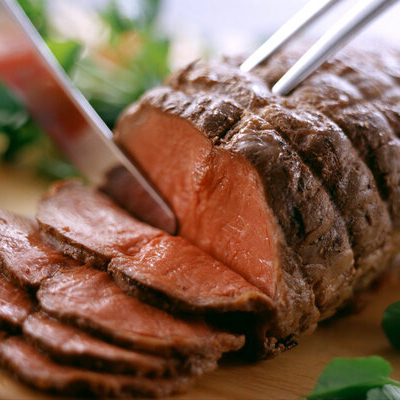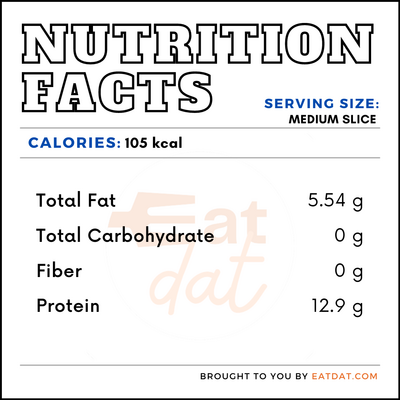
Roast Beef
What is Roast Beef?
Roast beef is a meat dish consisting of cuts of beef that are roasted. It is a popular dish among native English speaking populations and traditionally served in the UK, Ireland, Australia, New Zealand, South Africa, Canada, and the USA. This dish is served with different sauces and often paired with salads, Yorkshire pudding, or potatoes.
- The meat is brown in color, has a juicy and tender texture, with a savory taste.
- Also, it is the national dish of England.
There are different types of roast beef, depending on which part of the animal is used, including:
- Beef Brisket
- Tri-Tip Roast
- Chuck Roast
- Bottom Round Roast
- Scotch Tender
- Coulotte Roast
- Eye Round Roast
- Ribeye Roast
- Pork Butt
- Pork Loin Roast
- New York Strip Roast
- Whole Beef Tenderloin
Origin of roast beef
Though beef has been consumed by humans since prehistory, roast beef can trace its origins back to England and the reign of Henry VII. The royal guards would typically be served fresh roasted beef after church on Sundays and it soon became a ritual. Also, this gave the yeoman guards the nickname ‘beefeaters’. The tradition of Sunday roast spread throughout England and English populations throughout the world and is still considered a traditional Sunday or holiday meal. A ballad called ‘Roast Beef of Old England’ was written in the 1700s to commemorate this dish.
Nutrition
Nutritional profile for roast beef (medium slice):

In addition, roast beef also contains essential micronutrients such as calcium, magnesium, phosphorus, potassium, sodium, zinc, selenium, and choline. High beef consumption can lead to diseases such as colon cancer, inflammatory diseases such as atherosclerosis, diabetes, rheumatoid arthritis, macular degeneration, as well as infertility. However, if consumed in moderation, beef is a nutrient-dense food that increases the bioavailability of certain micronutrients.
Commercial production
The USA is the largest producer of beef in the world. Brazil, China, India, and Argentina, along with the US, account for 70 percent of the world’s production.
For preparing roast beef, the best cuts are the rib, sirloin, top rump, and fillet. The meat chosen must be moist with marbling that will provide the flavor to the roast. Also, the meat must be thawed to room temperature and then roasted in the oven. Seasonings may be added before putting it in the oven. This is done by rubbing olive oil (or any other oil) on the meat and sprinkling the salt and other seasonings over it. Finally, remove from the oven and let it rest for 30 minutes before cutting. The gravy for this dish is best made with the fat drippings accumulated during the roasting, some red wine, or beef stock, butter, and cornstarch.
Roast beef recipes
This dish can be prepared with different seasonings, such as garlic, and can use different cuts to provide variety. Leftover roasts can be used in different dishes as well. Cooked beef must be consumed within two hours of cooking and the leftovers refrigerated immediately. This dish can last for up to 4 days. Here are a few recipes to try:
- Roast Beef
- Garlic Lovers Roast Beef
- Marinated Roast Beef
- Beef Casserole
- Stroganoff
- Monday Pie
- Burritos
- Pot Pie
- Beef and Noodles
- Beef Pasta
- Roast Beef Sandwich
FDA regulations
The USDA regulates all meat products, including beef, which is defined as meat from full-grown cattle about 2 years old. The main cattle breeds used for producing beef are Angus, Hereford, Charolais, and Brahman. In the US, hormones are allowed to promote the growth of cattle. Grading of beef is voluntary and is graded as Prime, Choice, and Select.
References
- Beef From Farm To Table, Food Safety and Inspection Service (FSIS), US Department of Agriculture (USDA)
https://www.fsis.usda.gov/food-safety/safe-food-handling-and-preparation/meat/beef-farm-table#1 - Carol Wilson, A Brief History of Eating Beef, Hereford Beef
https://www.herefordbeef.org.uk/blog/a-brief-history-of-eating-beef/ - Klurfeld, David M. “What is the role of meat in a healthy diet?.” Animal frontiers : the review magazine of animal agriculture vol. 8,3 5-10. 7 Jul. 2018, doi:10.1093/af/vfy009
https://www.ncbi.nlm.nih.gov/pmc/articles/PMC7015455/ - Alisson-Silva, Frederico et al. “Human risk of diseases associated with red meat intake: Analysis of current theories and proposed role for metabolic incorporation of a non-human sialic acid.” Molecular aspects of medicine vol. 51 (2016): 16-30. doi:10.1016/j.mam.2016.07.002
https://www.ncbi.nlm.nih.gov/pmc/articles/PMC5035214/
